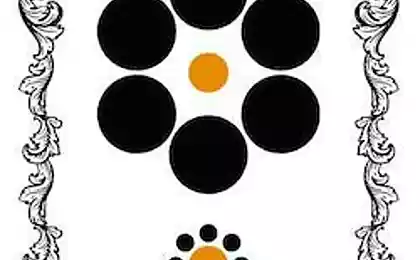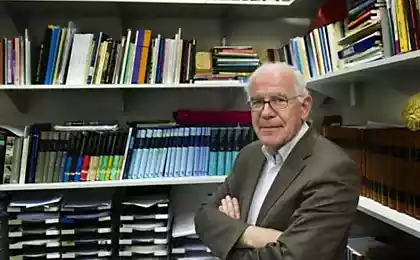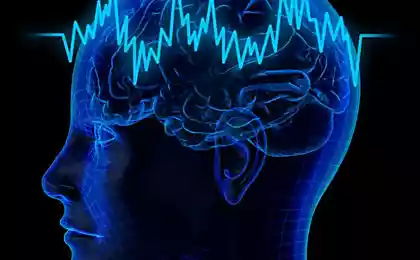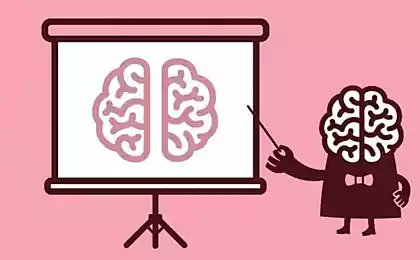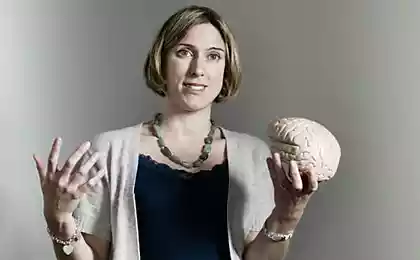710
Karma of the brain: are we condemned to live in illusion?
In all spiritual traditions is the notion that our perception of reality is distorted. In Hinduism and Buddhism speaks of the "veil of illusion" in Christianity — that we "see the world dimly, as if through a glass darkly".
Narozena Hasenkamp Wendy (Wendy Hazenkamp) in his article for the magazine Tricycle talks about how modern science explains the origin of this illusion at the level of the human brain. And how is it possible to change it.

It seems that people always want to change something: to buy the newest gadget, find a new job, to improve their relationship. Things that just “like to eat”, do not bring them complete satisfaction. Buddhists describe this situation by the term dukkha, meaning “suffering” and believe that dukkha is an intrinsic part of existence (although the term is indeed often translated as “suffering”, in fact in Pali dukkha means “restless impatience” — approx. TRANS.).
We often believe that we can achieve happiness by changing some external circumstances in our lives and in our environment. We ignore the fact that in large measure our suffering supports and perpetuates” our own mind. What habitual patterns of our mind determines our perception of events, our emotional responses to other people, and how we see the world as a whole: as “good” or “flawed”.
These patterns influence the most simple, basic expressions of our everyday life. Our mental and behavioral habits underlie the diversity of our life experience, and most of these habits we just don't realize. They rule our lives, and we live it on autopilot.
In Buddhism, these habits of our mind are directly related to the concept of karma. In each moment our consciousness is not free, but rigidly determined in what condition it was in prior moments, and the totality of our past experience defines the totality of our current experience. Our actions (which include not only our behavior, but also thoughts leave traces in our minds, and the likelihood that in the future we will do or will think about it also, increases.
The Korean Zen teacher, Deng kun Sumin (Sumin Daehaeng Kun) describes it this way: “People often treat lightly the thoughts that they allow to appear in his mind. They think that as soon as you forget this idea, it will cease to exist. This is not so. Once manifesting itself in your mind, the idea continues to function and once you return its consequences”.
But what is striking — these ancient ideas about karma (at least in the form in which they describe the relationship of cause and effect for one life) with remarkable accuracy reflect the views of neurogenic about how our brain works. One of the most fundamental principles of modern neuroscience was formulated in 1949, canadian neuropsychologist Donald Hebbian Donald Hebb's) and is known as “Hebb's law” or “theory of cell ensembles”. In his book “Organization of behavior: a neuropsychological theory he postulated the principle of interaction of neurons, which is often described in one sentence — “neurons, which are excited together, bind together (“Neurons that fire together, wire together”).
In this seminal work, Hebb suggested that “any two cells or systems of cells that are repetitive active at the same time, will gravitate to the connection, and activity in one cell or system of cells will facilitate the activation of other cells or systems of cells”. This is the basic premise of neuroplasticity — the ability of our brain to change in response to new experience.
The mechanism of neuroplasticity have been identified as a result of numerous rigorous scientific studies examining how the neural networks of our brains physically appear and are updated on a micro level. Imagine two neurons connected to each other so that the activity of the first neuron increases the probability of excitation of the second neuron. If we begin again and again to stimulate the two neurons at the same time, a few hours is exactly the same as before stimulation of the first neuron will lead to a stronger electrical response from the second neuron.
This is because the first cell will start to secrete more chemical neurotransmitters, and the second cell will create more receptors are able to perceive these neurotransmitters. These molecular changes will lead to the fact that the two neurons will emerge a stronger relationship. If this joint activation is repeated over a long period of time, the neurons physically change their shape — to grow new dendrites in order to strengthen the relationship.
This is the simplest example of how two cells interact with each other, and in the living brain are happening every second, millions of such interactions. Each neuron communicates more with thousands of other neurons, creating an incredibly complex network of connections. As a result of continuous process of the emergence of new, stable neural connections in our brain gradually formed a new neural network associated with that experience that repeats itself in our lives more often. These neural networks reflect our personal knowledge of each particular object, person or situation that appears in our experience as sensations, memories, emotions, thoughts and behavioral responses.
And as we live our life, those neural circuits that we use most often become stiff and incredibly stable. In practice, this means that they are included almost on the machine, and they are much easier to activate compared to new, previously unused, circuits. For primary activation of these old circuits need less power than to activate a new one, and then indulging your habits becomes, literally, “the path of least resistance”.
The brain can be compared with the mechanism of conservation of energy: 20 to 25% of cellular energy in our bodies is used by our brain (while its weight is about 2% of body weight), so the result of strong evolutionary pressure, the brain has learned to be as efficient and economical. Like a river, which prefers to flow in its direction, instead of having to pave a new path to the shore, when the brain has a choice between two actions, he chooses the one that he is well known and repeated many times, because it is energetically more profitable.
It is easy to see the connection between these studies and kanapia karma. Any of our subjective experience, ideas, and thoughts, emotions and feelings, behavior are reflected at the cellular level. Millions of neurons come to life in complex networks of interactions that underlie each of our experiences. The more often reproduced some specific patterns of activity of our mind, the deeper becomes a psychological rut. As a result, getting involved in some thought or action, we are more inclined in the future to repeat it again and again, as each our thought and our every action activate certain neural connections.
On the one hand, it can be viewed just as a mechanism of conservation of energy or the relationship between biological cause and effect. On the other hand, it is the law of karma, which is manifested daily in our regular life. Our brain literally becomes what we think.
These karmic aspects of neuroplasticity have important application. According to the Buddhist beliefs, the cause of suffering and impermanence are the illusion and ignorance — our inability to see the true nature of reality. Instead, to realize the impermanence and emptiness of all worldly manifestations, we tend to consider things as actually existing and unchanging, having an independent existence. We treat people and objects around us as separate, composed of disparate parts, and attributed to them a kind of innate personality. And not only that — we on top just as well apply to ourselves.
This is an erroneous perception of reality and is the cause of dukkha, with the result that we plunged into an endless stream of desires and disappointments, whose sole purpose is to protect and maintain our sense of “I”.
And the ability of our brain to be plastic leads to the fact that this illusion is maintained by the neural mechanism responsible for the formation of concepts. Let's look at an example of how there is a new concept in response to new visual stimuli. (This example is taken from the book by Thomas Lewis, Fari Amini and Richard Lannon “a General theory of love”).
Imagine a little girl who just started to learn letters. She first time sees a capital letter, and this letter is written in ornamental font. In that moment, when they see And, in the visual system of her brain is activated a group of neurons. In another she sees a different primer And this time its basis is the watermelon. Activates a slightly different set of neurons — it will have many of the same neurons that were activated for the first time (since the letter A in both cases there are common elements that stimulate the same neurons) but added new, and some from the first set will not. The third time the girl will see As written in some other font and re-activated the neurons associated with the same elements of letters, and some additional neurons.
Every time the child sees the same letter, written a little differently activated neurons related to the perception of the elements of the letters looked the same in all previous cases, and the law of Hebb they are stronger related to each other. In the case of the letters And such looking the same elements are two lines, located at an angle to each other and a horizontal line between them. When the brain begins to find and highlight these same elements in every new Simula, the child develops the concept of the letter “A”. Later it will be added to the sound and understanding the place of letters in a word.
As a result, each time a girl will see two connected oblique line and a horizontal line between them, in her mind, she will be immediately activated neural circuit, associiruyuschihsya with the perception of letters, and because of this it will be easy to read this letter and understand what she sees.
Conceptual processing of reality is incredibly convenient and helpful when it comes to the relationship with the world and other people. Thanks to the ability to create new concepts we can learn and remember. Without it simple tasks would put us at an impasse, because we would again and again, as if for the first time in my life, studied a spoon or a ballpoint pen, trying to guess their purpose.
But conceptual thinking is the reverse: by their very nature, well-established concepts violate the immediacy of our perception. In Buddhism this is known a long time ago. American scientist John Dunn (John Dunn) cites the example of the Buddhist philosopher Dharmakirti, who lived in the VII century. Dharmakirti argued that the face a few times with some unique element of the object, we generate the “false awareness”. It is the result of what our mind creates “sameness” (and this concept), highlighting all objects with the same element in a separate class because it is the most appropriate for our immediate needs. Because of the habit to operate sustainable concepts, we realize that in reality this element is a unique object. On the contrary, we believe that the concept in our head reflects a certain fundamental identity of this object.
Modern cognitive science also confirms the fact that conceptual thinking distracts us from direct perception. In the example with the letter A group of neurons associated with differences in writing, do not form sustainable relationships, because this visual stimulus is not repeated is the other side of the law Hebb. Due to the fact that increase connection only between neurons related to the perception of the same elementov, the emphasis in the minds of the girls shifting with a unique and distinctive parts of the familiar. It does not take uniqueness! The purity of her perception in some way violated. Conceptual filters in our brain give rise to the veil of illusion that hides from us the true reality.
We don't notice vzaimozavisimost and impermanence of the world around us, because we crystallizes our experience in pre-formed composite patterns that seem invariable in time. We do not see the voidness of things, because I believe that our concepts reflect the essence of things. It seems to us that a line connection is really yavlyaetsyato and will always be her.
When it comes to the letter it does not seem to be a serious problem. But the problem appears when we are as narrowly perceive people and more complex phenomenon, hanging on them for easier shortcuts. And, as a consequence, we do not see other people (and even themselves) in all of the uniqueness of the moment. It seems that the illusion is our incorrect perception of reality — is a natural consequence of a fundamental biological process, beautiful in its practicality and elegance, but also threatening us with large errors.
What are we to do? Are we destined to play out our lives, trusting in the mercy routine neural patterns? And Buddhism, and modern neuroscience are sure that no. The same neuroplastic properties of our brain through which we gain their karmic limitations, can help us to break free from illusion.
For centuries people have turned to contemplative practices, and their experience suggests that transformation is possible. And more recently neuroscience — partly thanks to his tandem with Buddhism — have discovered a previously unknown fact, that our brain can change throughout life. This is good news: if you regularly practice meditation, you can change your brain, with very significant.
The fact that the mechanism of neuroplasticity is constantly active, the brain constantly updates its neural network in response to current experience. If we begin to consciously choose your current experience, we can activate the needed parts of the brain.
Through regular practice of meditation we can begin to become aware of their mental habits. And seeing them, we can make the choice to follow them or try to change them, to try to react automatically, but consciously. And then we can form a new stable neural circuits. Over time, we can direct our river in a new direction.
But it is not easy. We begin to change deep-rooted mental habits that have formed for thousands, if not millions of repetitions. In addition, this reprogramming process requires a lot of energy — this also applies to the efforts that we make to, for example, not to allow the mind to wander, and cellular energy, which is necessary to create a new stable synaptic connections between neurons.
These processes at the biological level, reflect what in Buddhism is called “purification of karma”, and are the first step on the way to the realization that apart from our personal karma, there is also collective karma, which manifests itself in an equally deep-rooted social patterns of behavior and thinking, and encompassing not only our individual life.
We need to summon our spirit, because at times this job can be extremely exhausting, mentally and physically. As soon as our brain begins to experience a new neural pathway, the old gradually weakens due to rare use. And it's a very inspiring insight: change is possible, and the difficulties in the way of natural. Understanding that the creation of a new, stable neural circuits we need again and again to act and to think in new ways, helps us to gain patience in the practice of meditation. If we have devotion, we will be able to create new and healthy mental tendencies to wisdom and compassion, mindfulness and kindness. That is why the practice of meditation.
The question of how we can actually go beyond this illusion and to change the situation in which abstract concepts “embody” our current experience, still opened in neuroscience. As we know, Buddhism says that man can begin to perceive the world directly and discover the voidness that is beyond all concepts.
From a biological point of view, we probably will never be able to completely negate a physical manifestation of the structures of our brain, responsible for conceptual thinking. In the end, it is essential for intelligent functioning in the world. But thanks to the practice of meditation we can change our attitude towards our concepts, we can see their Foundation. And then gradually we will be able to lift the veil of Maya and see the true nature of reality.
About the author:
Wendy Hasenkamp — doctor of science and a senior researcher at the Institute of mind and life created by the Dalai Lama together with leading Western scholars. In her research exploring how mindfulness and mind wandering are manifested at the level of neural connections.
Author: Wendy Hasenkamp (Wendy Hazenkamp)
Translation: Anastasia Gosteva
P. S. And remember, just changing your mind — together we change the world! ©
Source: vnimatelnost.com/2014/08/11/brain-karma/
Narozena Hasenkamp Wendy (Wendy Hazenkamp) in his article for the magazine Tricycle talks about how modern science explains the origin of this illusion at the level of the human brain. And how is it possible to change it.

It seems that people always want to change something: to buy the newest gadget, find a new job, to improve their relationship. Things that just “like to eat”, do not bring them complete satisfaction. Buddhists describe this situation by the term dukkha, meaning “suffering” and believe that dukkha is an intrinsic part of existence (although the term is indeed often translated as “suffering”, in fact in Pali dukkha means “restless impatience” — approx. TRANS.).
We often believe that we can achieve happiness by changing some external circumstances in our lives and in our environment. We ignore the fact that in large measure our suffering supports and perpetuates” our own mind. What habitual patterns of our mind determines our perception of events, our emotional responses to other people, and how we see the world as a whole: as “good” or “flawed”.
These patterns influence the most simple, basic expressions of our everyday life. Our mental and behavioral habits underlie the diversity of our life experience, and most of these habits we just don't realize. They rule our lives, and we live it on autopilot.
In Buddhism, these habits of our mind are directly related to the concept of karma. In each moment our consciousness is not free, but rigidly determined in what condition it was in prior moments, and the totality of our past experience defines the totality of our current experience. Our actions (which include not only our behavior, but also thoughts leave traces in our minds, and the likelihood that in the future we will do or will think about it also, increases.
The Korean Zen teacher, Deng kun Sumin (Sumin Daehaeng Kun) describes it this way: “People often treat lightly the thoughts that they allow to appear in his mind. They think that as soon as you forget this idea, it will cease to exist. This is not so. Once manifesting itself in your mind, the idea continues to function and once you return its consequences”.
But what is striking — these ancient ideas about karma (at least in the form in which they describe the relationship of cause and effect for one life) with remarkable accuracy reflect the views of neurogenic about how our brain works. One of the most fundamental principles of modern neuroscience was formulated in 1949, canadian neuropsychologist Donald Hebbian Donald Hebb's) and is known as “Hebb's law” or “theory of cell ensembles”. In his book “Organization of behavior: a neuropsychological theory he postulated the principle of interaction of neurons, which is often described in one sentence — “neurons, which are excited together, bind together (“Neurons that fire together, wire together”).
In this seminal work, Hebb suggested that “any two cells or systems of cells that are repetitive active at the same time, will gravitate to the connection, and activity in one cell or system of cells will facilitate the activation of other cells or systems of cells”. This is the basic premise of neuroplasticity — the ability of our brain to change in response to new experience.
The mechanism of neuroplasticity have been identified as a result of numerous rigorous scientific studies examining how the neural networks of our brains physically appear and are updated on a micro level. Imagine two neurons connected to each other so that the activity of the first neuron increases the probability of excitation of the second neuron. If we begin again and again to stimulate the two neurons at the same time, a few hours is exactly the same as before stimulation of the first neuron will lead to a stronger electrical response from the second neuron.
This is because the first cell will start to secrete more chemical neurotransmitters, and the second cell will create more receptors are able to perceive these neurotransmitters. These molecular changes will lead to the fact that the two neurons will emerge a stronger relationship. If this joint activation is repeated over a long period of time, the neurons physically change their shape — to grow new dendrites in order to strengthen the relationship.
This is the simplest example of how two cells interact with each other, and in the living brain are happening every second, millions of such interactions. Each neuron communicates more with thousands of other neurons, creating an incredibly complex network of connections. As a result of continuous process of the emergence of new, stable neural connections in our brain gradually formed a new neural network associated with that experience that repeats itself in our lives more often. These neural networks reflect our personal knowledge of each particular object, person or situation that appears in our experience as sensations, memories, emotions, thoughts and behavioral responses.
And as we live our life, those neural circuits that we use most often become stiff and incredibly stable. In practice, this means that they are included almost on the machine, and they are much easier to activate compared to new, previously unused, circuits. For primary activation of these old circuits need less power than to activate a new one, and then indulging your habits becomes, literally, “the path of least resistance”.
The brain can be compared with the mechanism of conservation of energy: 20 to 25% of cellular energy in our bodies is used by our brain (while its weight is about 2% of body weight), so the result of strong evolutionary pressure, the brain has learned to be as efficient and economical. Like a river, which prefers to flow in its direction, instead of having to pave a new path to the shore, when the brain has a choice between two actions, he chooses the one that he is well known and repeated many times, because it is energetically more profitable.
It is easy to see the connection between these studies and kanapia karma. Any of our subjective experience, ideas, and thoughts, emotions and feelings, behavior are reflected at the cellular level. Millions of neurons come to life in complex networks of interactions that underlie each of our experiences. The more often reproduced some specific patterns of activity of our mind, the deeper becomes a psychological rut. As a result, getting involved in some thought or action, we are more inclined in the future to repeat it again and again, as each our thought and our every action activate certain neural connections.
On the one hand, it can be viewed just as a mechanism of conservation of energy or the relationship between biological cause and effect. On the other hand, it is the law of karma, which is manifested daily in our regular life. Our brain literally becomes what we think.
These karmic aspects of neuroplasticity have important application. According to the Buddhist beliefs, the cause of suffering and impermanence are the illusion and ignorance — our inability to see the true nature of reality. Instead, to realize the impermanence and emptiness of all worldly manifestations, we tend to consider things as actually existing and unchanging, having an independent existence. We treat people and objects around us as separate, composed of disparate parts, and attributed to them a kind of innate personality. And not only that — we on top just as well apply to ourselves.
This is an erroneous perception of reality and is the cause of dukkha, with the result that we plunged into an endless stream of desires and disappointments, whose sole purpose is to protect and maintain our sense of “I”.
And the ability of our brain to be plastic leads to the fact that this illusion is maintained by the neural mechanism responsible for the formation of concepts. Let's look at an example of how there is a new concept in response to new visual stimuli. (This example is taken from the book by Thomas Lewis, Fari Amini and Richard Lannon “a General theory of love”).
Imagine a little girl who just started to learn letters. She first time sees a capital letter, and this letter is written in ornamental font. In that moment, when they see And, in the visual system of her brain is activated a group of neurons. In another she sees a different primer And this time its basis is the watermelon. Activates a slightly different set of neurons — it will have many of the same neurons that were activated for the first time (since the letter A in both cases there are common elements that stimulate the same neurons) but added new, and some from the first set will not. The third time the girl will see As written in some other font and re-activated the neurons associated with the same elements of letters, and some additional neurons.
Every time the child sees the same letter, written a little differently activated neurons related to the perception of the elements of the letters looked the same in all previous cases, and the law of Hebb they are stronger related to each other. In the case of the letters And such looking the same elements are two lines, located at an angle to each other and a horizontal line between them. When the brain begins to find and highlight these same elements in every new Simula, the child develops the concept of the letter “A”. Later it will be added to the sound and understanding the place of letters in a word.
As a result, each time a girl will see two connected oblique line and a horizontal line between them, in her mind, she will be immediately activated neural circuit, associiruyuschihsya with the perception of letters, and because of this it will be easy to read this letter and understand what she sees.
Conceptual processing of reality is incredibly convenient and helpful when it comes to the relationship with the world and other people. Thanks to the ability to create new concepts we can learn and remember. Without it simple tasks would put us at an impasse, because we would again and again, as if for the first time in my life, studied a spoon or a ballpoint pen, trying to guess their purpose.
But conceptual thinking is the reverse: by their very nature, well-established concepts violate the immediacy of our perception. In Buddhism this is known a long time ago. American scientist John Dunn (John Dunn) cites the example of the Buddhist philosopher Dharmakirti, who lived in the VII century. Dharmakirti argued that the face a few times with some unique element of the object, we generate the “false awareness”. It is the result of what our mind creates “sameness” (and this concept), highlighting all objects with the same element in a separate class because it is the most appropriate for our immediate needs. Because of the habit to operate sustainable concepts, we realize that in reality this element is a unique object. On the contrary, we believe that the concept in our head reflects a certain fundamental identity of this object.
Modern cognitive science also confirms the fact that conceptual thinking distracts us from direct perception. In the example with the letter A group of neurons associated with differences in writing, do not form sustainable relationships, because this visual stimulus is not repeated is the other side of the law Hebb. Due to the fact that increase connection only between neurons related to the perception of the same elementov, the emphasis in the minds of the girls shifting with a unique and distinctive parts of the familiar. It does not take uniqueness! The purity of her perception in some way violated. Conceptual filters in our brain give rise to the veil of illusion that hides from us the true reality.
We don't notice vzaimozavisimost and impermanence of the world around us, because we crystallizes our experience in pre-formed composite patterns that seem invariable in time. We do not see the voidness of things, because I believe that our concepts reflect the essence of things. It seems to us that a line connection is really yavlyaetsyato and will always be her.
When it comes to the letter it does not seem to be a serious problem. But the problem appears when we are as narrowly perceive people and more complex phenomenon, hanging on them for easier shortcuts. And, as a consequence, we do not see other people (and even themselves) in all of the uniqueness of the moment. It seems that the illusion is our incorrect perception of reality — is a natural consequence of a fundamental biological process, beautiful in its practicality and elegance, but also threatening us with large errors.
What are we to do? Are we destined to play out our lives, trusting in the mercy routine neural patterns? And Buddhism, and modern neuroscience are sure that no. The same neuroplastic properties of our brain through which we gain their karmic limitations, can help us to break free from illusion.
For centuries people have turned to contemplative practices, and their experience suggests that transformation is possible. And more recently neuroscience — partly thanks to his tandem with Buddhism — have discovered a previously unknown fact, that our brain can change throughout life. This is good news: if you regularly practice meditation, you can change your brain, with very significant.
The fact that the mechanism of neuroplasticity is constantly active, the brain constantly updates its neural network in response to current experience. If we begin to consciously choose your current experience, we can activate the needed parts of the brain.
Through regular practice of meditation we can begin to become aware of their mental habits. And seeing them, we can make the choice to follow them or try to change them, to try to react automatically, but consciously. And then we can form a new stable neural circuits. Over time, we can direct our river in a new direction.
But it is not easy. We begin to change deep-rooted mental habits that have formed for thousands, if not millions of repetitions. In addition, this reprogramming process requires a lot of energy — this also applies to the efforts that we make to, for example, not to allow the mind to wander, and cellular energy, which is necessary to create a new stable synaptic connections between neurons.
These processes at the biological level, reflect what in Buddhism is called “purification of karma”, and are the first step on the way to the realization that apart from our personal karma, there is also collective karma, which manifests itself in an equally deep-rooted social patterns of behavior and thinking, and encompassing not only our individual life.
We need to summon our spirit, because at times this job can be extremely exhausting, mentally and physically. As soon as our brain begins to experience a new neural pathway, the old gradually weakens due to rare use. And it's a very inspiring insight: change is possible, and the difficulties in the way of natural. Understanding that the creation of a new, stable neural circuits we need again and again to act and to think in new ways, helps us to gain patience in the practice of meditation. If we have devotion, we will be able to create new and healthy mental tendencies to wisdom and compassion, mindfulness and kindness. That is why the practice of meditation.
The question of how we can actually go beyond this illusion and to change the situation in which abstract concepts “embody” our current experience, still opened in neuroscience. As we know, Buddhism says that man can begin to perceive the world directly and discover the voidness that is beyond all concepts.
From a biological point of view, we probably will never be able to completely negate a physical manifestation of the structures of our brain, responsible for conceptual thinking. In the end, it is essential for intelligent functioning in the world. But thanks to the practice of meditation we can change our attitude towards our concepts, we can see their Foundation. And then gradually we will be able to lift the veil of Maya and see the true nature of reality.
About the author:
Wendy Hasenkamp — doctor of science and a senior researcher at the Institute of mind and life created by the Dalai Lama together with leading Western scholars. In her research exploring how mindfulness and mind wandering are manifested at the level of neural connections.
Author: Wendy Hasenkamp (Wendy Hazenkamp)
Translation: Anastasia Gosteva
P. S. And remember, just changing your mind — together we change the world! ©
Source: vnimatelnost.com/2014/08/11/brain-karma/









